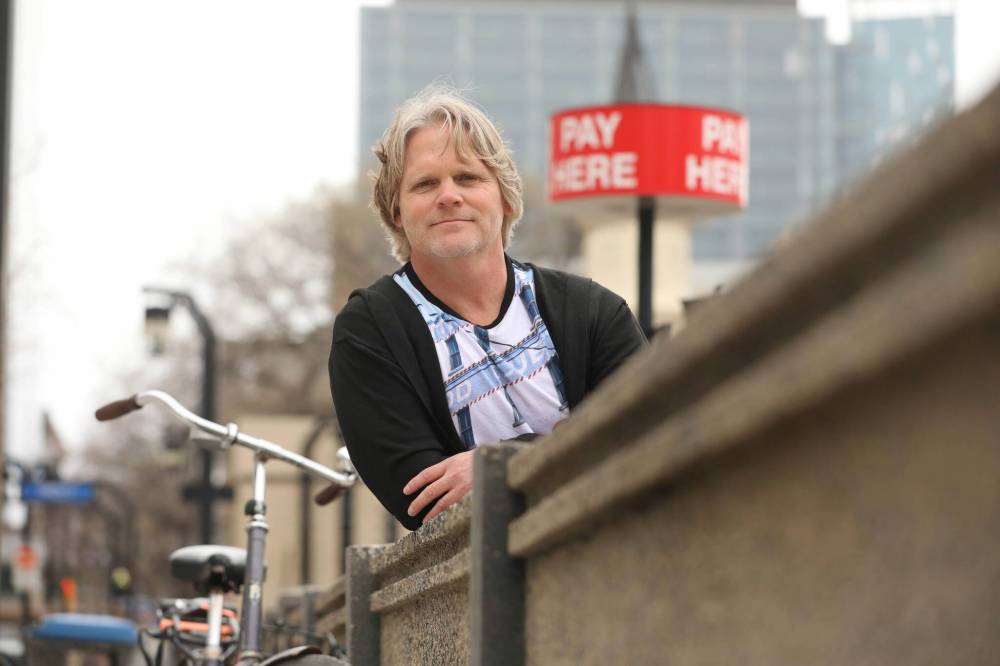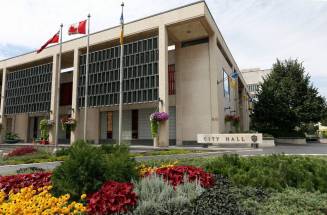Election at a point of inflection A new mayor and council need visionary city-building policies to fix Winnipeg's economic and geographic challenges
Read this article for free:
or
Already have an account? Log in here »
To continue reading, please subscribe:
Monthly Digital Subscription
$0 for the first 4 weeks*
- Enjoy unlimited reading on winnipegfreepress.com
- Read the E-Edition, our digital replica newspaper
- Access News Break, our award-winning app
- Play interactive puzzles
*No charge for 4 weeks then price increases to the regular rate of $19.00 plus GST every four weeks. Offer available to new and qualified returning subscribers only. Cancel any time.
Monthly Digital Subscription
$4.75/week*
- Enjoy unlimited reading on winnipegfreepress.com
- Read the E-Edition, our digital replica newspaper
- Access News Break, our award-winning app
- Play interactive puzzles
*Billed as $19 plus GST every four weeks. Cancel any time.
To continue reading, please subscribe:
Add Free Press access to your Brandon Sun subscription for only an additional
$1 for the first 4 weeks*
*Your next subscription payment will increase by $1.00 and you will be charged $16.99 plus GST for four weeks. After four weeks, your payment will increase to $23.99 plus GST every four weeks.
Read unlimited articles for free today:
or
Already have an account? Log in here »
Hey there, time traveller!
This article was published 12/10/2022 (1152 days ago), so information in it may no longer be current.
The approaching election is coming at a time when the world seems filled with uncertainty. The future feels unpredictable and our path forward less defined. In the past, civic elections have often been distilled down to police, pipes and pavement, but today we are facing broader city-building conversations. Issues that have been building for many years are converging with more recent challenges to create obstacles of generational impact. As we vote, now more than ever, we must remember that the decisions we make today will define the city we pass on to our children.
The global pandemic has ripped open the severe social divisions that have long existed in our city. The challenges of poverty and homelessness have never been so acute or so visible, with bus shelters serving as temporary homes and riverbanks as temporary encampments.
The pandemic has also devastated small businesses across the city, most significantly downtown, where more than 50 storefront shops have permanently closed and 1.5 million square feet of office space now sits vacant. The pre-COVID momentum of downtown growth and renewal has been set back decades, with major streets, such as Portage Avenue, now lined with hollowed-out buildings and vacant storefronts.
MIKE SUDOMA / WINNIPEG FREE PRESS FILES. The pre-COVID momentum of downtown growth and renewal has been set back decades, with major streets, such as Portage Avenue, now lined with hollowed-out buildings and vacant storefronts.
As we move out of the pandemic, we are seeing inflation rates soar, with historic cost-of-living increases that are creating even wider economic schisms in our city. Since 2020, the cost of gasoline has doubled, the average price of a used vehicle has increased by 35 per cent, and the average cost of a house in Winnipeg has increased by 25 per cent.
Climate change has also quickly moved from being a theory we debated “believing in” to something we experience with regularity through more frequent extreme-weather events such as heat waves, polar vortex outbreaks, drought and storms. This comes as we watch the accelerated devastation to one of our most effective tools for creating climate resiliency, a mature tree canopy that has, for decades, absorbed rainfall and stormwater runoff, as well as carbon and air pollution, while providing shade and cooling to our homes and neighbourhoods.
Compounding these challenges is the fact that Winnipeg is broke. The city’s latest financial report predicted a $60 million deficit in the operating budget and a $15 million shortfall for Winnipeg Transit. The impacts of COVID have pushed civic finances over the cliff, but the city’s economic viability has been tenuous for many years. The impacts of this shortfall have been seen in ever-diminishing services and program funding, as well as an infrastructure deficit that now sits at $7 billion. Our current pace of renewal means new roads built today won’t be replaced for more than 100 years. Our public tree-pruning cycle is 27 years, far longer than the recommended seven years, and just one public tree is planted for every three that are removed.
The impacts of COVID have pushed civic finances over the cliff, but the city’s economic viability has been tenuous for many years. The impacts of this shortfall have been seen in ever-diminishing services and program funding, as well as an infrastructure deficit that now sits at $7 billion.
This all paints a dire picture, with the challenges to our city seeming insurmountable, but there are city-building solutions able to address many of these issues, if we are bold enough to push our new mayor and council towards them.
The sustainable path forward starts by addressing Winnipeg’s uncontrolled consumption of farmland to accommodate population growth by shifting to stronger civic policy that moves growth inward at a much greater intensity than it has in the past. This isn’t an opinion, it’s simple math. Winnipeg’s sprawling, low-density land-use policies have resulted in the city growing almost three times faster in land area than it is in population. As Winnipeg’s population grew over the last 50 years, if it had simply been able to maintain the same density it had in the 1970s, the city would be almost one-third smaller in land area than it is today.
This larger footprint has a cascading effect across a broad range of issues, the first of which is economic. Lower density means that every tax dollar collected by the city today is required to support about 40 per cent more land area and corresponding infrastructure than it did 50 years ago. If we consider infrastructure such as water pipes as an example, each Winnipegger today is responsible for 70 per cent more length of pipe than they were in the 1970s. This increased pressure on tax dollars results in maintenance being deferred, services being reduced and less money in the public purse to pursue other environmental and quality-of-life initiatives, such as a full investment in protecting the tree canopy or supporting local arts and culture.
Most of Winnipeg’s mature neighbourhoods have about 30 per cent fewer people living in them today than in the 1970s, largely because of smaller household sizes. This results in the schools, libraries and community centres in those areas being underused, while at the same time we are building new facilities to support new neighbourhoods.
Most of Winnipeg’s mature neighbourhoods have about 30 per cent fewer people living in them today than in the 1970s, largely because of smaller household sizes.
By creating civic policies that lead to greater intensification of our existing neighbourhoods, we can accommodate population growth while maximizing use of our existing infrastructure and services. This is prudent economic policy and has a significant environmental impact by reducing the carbon emissions created through new construction, greenfield land development and long-term operation of new buildings. A more compact city also saves money on garbage collection, snow clearing, police, fire, paramedics and other services impacted by distance.
A geographically larger city with greater travel distances has led to private automobiles being the only viable form of transportation for many citizens. Vehicle ownership per capita has grown by 20 per cent in only 20 years. The number of private vehicles on Winnipeg’s roads increases by about 7,500 every year, the cause of ever-worsening traffic congestion and costly wear and tear on our streets. At the same time, 40 per cent fewer people use public transit today than in the 1980s, and before the pandemic Winnipeg was the only major Canadian city that had lower transit ridership than it did 20 years ago.
MIKAELA MACKENZIE / WINNIPEG FREE PRESS FILES The city’s latest financial report predicted a $60 million deficit in the operating budget and a $15 million shortfall for Winnipeg Transit.
The environmental impact of our car-first urban design policies is that almost half of all greenhouse-gas emissions in Winnipeg come from vehicles — by far the largest source. To meet our climate-change targets, reduce traffic congestion and road wear, the only solution is to encourage more people to drive less. This will require a civic government devoted to building and investing in alternate modes of transportation including transit, cycling and walking. It has been demonstrated across North America that when a city invests in more frequent and reliable transit, more people ride the bus, and when it builds cycling infrastructure, more people ride a bike. Mode-share growth occurs in an almost direct relationship with the investment. The formula is not difficult, but finding the public commitment is.
If implemented well, public-transit investment can do more than get people out of their cars, it can be used as a powerful neighbourhood-development tool. When a system is effective, residents and businesses want to locate near transit stations, which can spur new transit-oriented development and increase adjacent property values. Planners can use the gravity of transit stations to target locations for renewal and infill growth in existing communities, reaping the environmental benefits of higher density, as well as greater public-transit use.
Public transit is also a key investment strategy to revive our struggling downtown. Winnipeg Transit’s new master plan will create central rapid-transit stations at Portage and Main and Union Station on Broadway. This will be an opportunity to establish major multi-modal hubs in the downtown that attract tens of thousands of people every day, creating a catalyst for new businesses and residential growth. The high-speed priority lines will run down the centre of Portage Avenue and Main Street, with stops located in the median, similar to Winnipeg’s old streetcar network. This new strategy creates significant opportunity to maximize impact by dovetailing it with urban-planning improvements that make downtown a place to walk, live and visit. These changes include removing one-way traffic, narrowing streets and using the space to widen sidewalks, plant trees and add bike lanes, using tax-increment financing to support affordable-housing construction and heritage-building redevelopment, investing in public art and improving public spaces. An exciting opportunity exists to leverage significant federal and provincial investment in public transit to achieve planning changes that reimagine downtown as a vibrant mixed-use neighbourhood that people can fall in love with.
To maximize public investment in transit and active transportation across the city, civic policy must go beyond buying more buses or laying more bike paths. To ensure these are effective mobility options, commitments to neighbourhood density and diversity are again key factors. Shorter travel distances, integrated mobility options and having as many people living and working as close to the infrastructure as possible means more people will use and support it.
To maximize public investment in transit and active transportation across the city, civic policy must go beyond buying more buses or laying more bike paths.
With housing and transportation being two key drivers of inflation, and representing 50 per cent of Canadian household spending, designing neighbourhoods that allow people to drive less or own fewer vehicles is an important strategy to combat the rising cost of living and improve social equity by offering greater access to education, employment and recreation for those who cannot afford the cost of owning a vehicle. The Housing + Transportation Affordability Index in the United States studied 20 metropolitan areas and found combined housing and transportation costs consumed up to 20 per cent less household income in neighbourhoods where walking, biking and public transit are more viable transportation options compared with car-oriented neighbourhoods.
There are many key policy directions that can help achieve higher density, more diverse, walkable, transit-friendly and affordable neighbourhoods. Relaxing density restrictions on multi-family housing would allow developers to divide land values and other development costs among a greater number of units, helping to make rents more affordable and infill projects more viable. Another important strategy is for governments to stop mandating minimum numbers of parking stalls required for new developments. Allowing developers to build what they believe is appropriate for the market generally results in significantly fewer stalls being built, meaning the construction cost — which can be as much as $60,000 for an underground parking stall — is no longer baked into rents or purchase prices.

To create greater housing affordability, cities must increase supply by simply allowing more housing to be built while promoting or incentivizing construction of more diverse housing options that include secondary suites, duplexes, triplexes and apartments embedded within existing neighbourhoods and on residential streets. Many cities are now looking at completely eliminating single-family zoning to allow more diverse and higher-density housing options in residential areas. Minneapolis recently did this, with every residential lot now permitted to have as many as three residences built on it without requiring a variance. Our society is changing; almost 30 per cent of Canadian households today are people living alone, families are having fewer children and the population is aging, with more seniors wanting to stay in their communities as their housing needs change. Our neighbourhoods can’t be frozen in time, unable to evolve and respond to demographic and economic change.
Our society is changing; almost 30 per cent of Canadian households today are people living alone, families are having fewer children and the population is aging, with more seniors wanting to stay in their communities as their housing needs change.
We have seen how much resistance people have towards change, and the idea of welcoming more and different neighbours into their community often faces impassioned opposition. Zoning regulations that allow new residents into a neighbourhood only if they can afford the cost of a single-family home, however, creates exclusionary economic barriers to neighbourhood access that affect a higher proportion of racialized residents and contributes to a widening wealth gap between communities, with cyclical intergenerational effects.
Zoning and policies that focus on building more diverse and inclusive neighbourhoods are vital to addressing the racial and economic inequality. Where a person lives affects all aspects of their life. Reduced access to socio-economically integrated schools can affect performance for lower-income students and be a barrier to finding diverse friend networks. House values in less-diverse neighbourhoods are frequently suppressed, reducing accumulated wealth for families. Employment, recreation and green space are often concentrated in wealthier, less-diverse neighbourhoods, creating barriers for people to improve their economic status and quality of life.
RUTH BONNEVILLE / WINNIPEG FREE PRESS FILES Brent Bellamy is senior design architect for Number 10 Architectural Group.
More diverse housing in our neighbourhoods is a long-term strategy to create generational social and economic equity, but the issue of homelessness specifically requires a more immediate response. Finland offers a bold and seemingly obvious solution that cities such as Winnipeg could follow: the government simply built homes for the homeless. Over a 10-year period, Finland built 4,000 new homes specifically for homeless people, using a Housing First policy. This cut homelessness in half across the country, which now has a goal of eliminating it by 2027. Housing is seen as a provincial responsibility, but cities have a role to play by offering land, co-ordinating partnerships and even making investments in new construction.
Progressive cities are embracing a new way forward by responding to challenges with visionary city-building policies that are establishing more dense and diverse neighbourhoods to make their cities healthier, more vibrant, prosperous, equitable and environmentally sustainable. As we all listen to campaign promises and evaluate which candidates we will vote for on Oct. 26, it is important to remember that if we continue to build a city of the past, the challenges of the past will continue to grow, but if we strive to build a city for the future, we can meet those challenges in new ways and pass a better city to the next generations.
Brent Bellamy is senior design architect for Number 10 Architectural Group.

Brent Bellamy is senior design architect for Number Ten Architectural Group.
Our newsroom depends on a growing audience of readers to power our journalism. If you are not a paid reader, please consider becoming a subscriber.
Our newsroom depends on its audience of readers to power our journalism. Thank you for your support.









